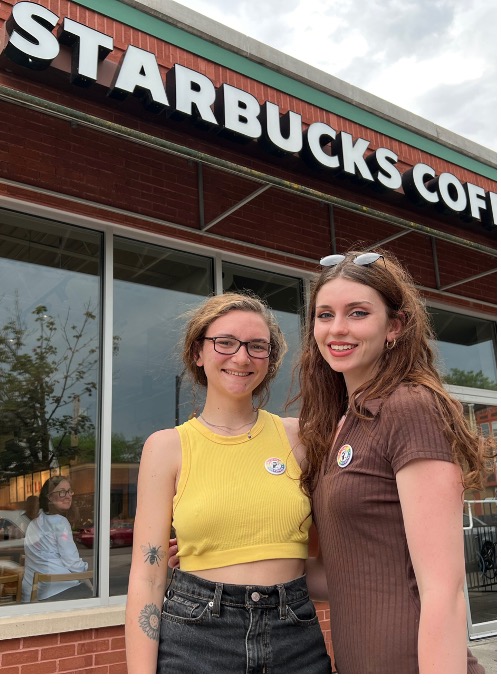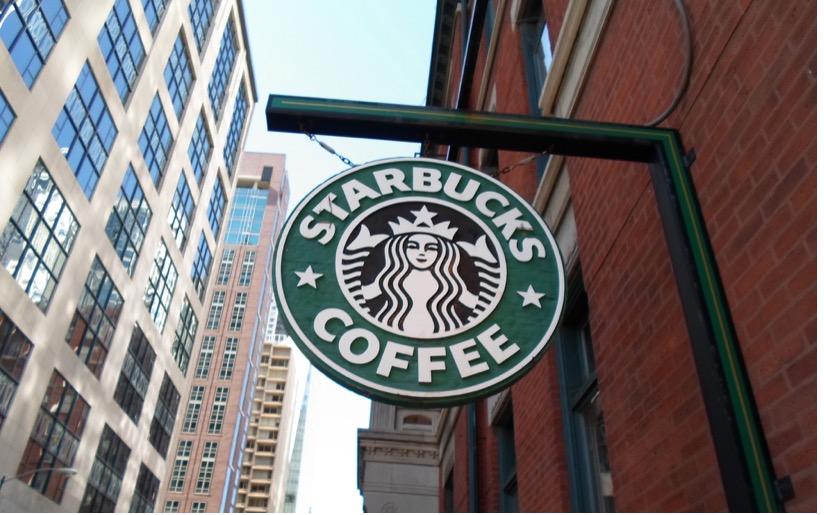CommentsLABOR WATCH - Veronica Gonzalez can’t wait until July. That’s when a union election is scheduled for the Starbucks store where the 26-year-old barista works with 40 others in the Cypress Park neighborhood near downtown Los Angeles.
“July is just around the corner, and I’m looking forward to negotiating a contract to show this new generation of young people how a union can benefit my workplace and all of the people I work with,” Gonzalez said this week. Desire for higher pay, more secure work hours and greater control over the pace of work are central issues for Gonzalez and her colleagues.
Gonzalez is one of dozens of local Starbucks employees in the Los Angeles area who have joined a national movement to unionize Starbucks stores that began in Buffalo, New York, in December 2021. Just yesterday, Starbucks employees at a store in Anaheim voted 10 to 1 to join Workers United, a national union affiliated with the Service Employees International Union, which is assisting the largely grass-roots organizing campaign. (Disclosure: SEIU is a financial supporter of Capital & Main.)
Andrea Olivares, a 24-year-old barista who led the organizing effort in Anaheim, talks about how her parents, who immigrated from Mexico, inspired her efforts. “My parents worked hard in warehouses and were mistreated so they have been 100% supportive of me pushing for the union,” Olivares said just after the National Labor Relations Board certified the vote count on Thursday. A vote at the large Downtown Disney location in Anaheim is scheduled for next week. The first election to unionize a Starbucks in Los Angeles took place on May 23at the store in Little Tokyo in downtown, which workers won 5-0.
Starbucks, which has 9,000 company-operated stores nationwide, initiated an all-out effort to stop the wave of unionizing activity after the early Buffalo victories. Jesse De La Cruz, who led the Little Tokyo organizing campaign, claims that after signing a letter to Starbucks management stating his intention to form a union, he had his hours cut and all of the workers were subjected to two-on-one interviews with store managers and regional managers. “They told us we could lose our benefits, might not get raises or a 401k contribution, and they started to find reasons to fire me,” De La Cruz said. “It’s intimidating to 17-, 18- and 19-year-olds to have to go through that, especially when they may not even know what a union is,” he added.
Starbucks has also hired Littler Mendelson, a notoriously anti-union law firm based in San Francisco, to oversee the union obstruction campaign. Traditional anti-union tactics include punishing pro-union employees, changing the make-up of the workforce that is allowed to vote, and so-called captive audience meetings where anti-union propaganda is disseminated to workers. As negotiations commence for the stores that have already won elections, the baristas and other workers will soon be sitting across the bargaining table from some of the highest-priced attorneys in the country. “I’m not afraid of their attorneys,” De La Cruz said, “and I told my fellow partners not to be afraid.” De La Cruz has had his hours cut to weekends, which he says is retaliation and an attempt to keep him out of the store.
De La Cruz plans to be at the table when negotiations commence. He’ll be pushing for $24 an hour starting pay for baristas to keep up with the cost of living in Los Angeles and inflation. Currently new hires start at $16 an hour. He’s currently making $21 an hour as a shift supervisor
When reached for comment, a Starbucks spokesperson said, “The majority of partners at the Katella store in Anaheim, CA, voted to be represented by the union. As we have said throughout, we will respect the process and will bargain in good faith guided by our principles laid out in this letter from Rossann Williams, evp and president, North America. We hope that the union does the same.”
The spokesperson rebuffed claims of retaliation. “We have fully honored the process laid out by the NLRB and have encouraged our partners to exercise their right to vote in the election to have their voices heard. Any claims of anti-union activity are categorically false.”
However, the day after Starbucks workers in Anaheim voted to unionize, Starbucks CEO Howard Schultz told a New York Times reporter at a live event that he would never embrace the union as a trusted partner. “The customer experience will be significantly challenged and less than,” Schultz said, “if a third party is integrated into our business.”
When told about Schultz’s comments, De La Cruz replied that “We are not a third party, we are the workers in the stores who voted for the union.”
“The customer’s experience has been impacted primarily by the fact that ever since Starbucks started emphasizing drive-throughs which are more profitable, employees have been overworked,” De La Cruz added.
How the National Movement Began

Victoria Conklin and Sarah Moore. Photo by Kelly Candaele.
Nationwide, according to a Workers United spokesperson, approximately 280 union election petitions have been filed at Starbucks stores. Elections have taken place at 163 stores with the union winning representation at 136 while losing elections at 17 stores. Ten elections are in the process of being challenged.
Last week, at a cafe a short distance down the street from the first Starbucks store to unionize in Buffalo, New York, Victoria Conklin and Sarah Moore talked about why they decided to form a union and how their younger generation of workers used social media to drive the organizing efforts. Conklin’s and Moore’s parents are or were members of unions, the IBEW and the local teachers union, respectively, so they came to the organizing efforts with more understanding of what unions do.
After the first store in Buffalo was organized, Starbucks corporate managers rushed to the city in an attempt to stop union enthusiasm from spreading. “They had corporate people coming in here saying they were going to fix everything that was wrong and get things straightened out, and they would turn off the mobile orders when we got too busy,” Conklin explained. “But when we still decided to unionize, all of that went away because they didn’t actually care about us. We’re just money-making machines to them.” Conklin, 24, has also been written up for workplace violations and lost hours since coming out as a union leader.
Moore, who is a 20-year-old student at the University of Buffalo, was initially not interested in union efforts at her store. “At first I was intimidated by all the anti-union communications the managers made us listen to, like they couldn’t control if our store closed and we are going to be paying all this money in union dues,” Moore said. “Looking back on that experience, it was just garbage attempting to split us up and intimidate us.”
Howard Schultz, the current CEO of Starbucks, even made a visit to Buffalo in late 2021 in a last-ditch attempt to stop unionization efforts. “I think having Schultz here and all the other top managers was Starbucks’ way of punishing Buffalo for being the first to organize,” Conklin speculated.
While getting up from the table to walk down the street to the Elmwood Starbucks store, a union teacher sitting nearby told the two young organizers that he had overheard their conversation and that “teachers have your back.” “It’s a great feeling knowing we have community support,” Moore responded.
Labor historians have pointed out that Buffalo has a deep tradition of working-class organizing and politics dating back to the 1930s, while others close to the current movement point to various dynamics that are driving the current effort. Casey Moore, a Starbucks employee in Williamsville, a suburb of Buffalo, claims that Starbucks’ attempts to brand the company as progressive and hip have backfired. “They have tried to cultivate an image as a benevolent employer by hiring young and energetic people who have been involved in the Black Lives Matter and LGBTQ movements,” Moore said. “This is a workforce of millennials and Gen Z people who don’t see a lot of hope, but we’ve proven we can be activists both inside and outside of the workplace.”
Even though the first Starbucks store voted to unionize in December of last year, there is still no union contract at that locationas negotiations have proceeded slowly. If Starbucks can show that there will be no significant benefits to unionization it could discourage other stores from organizing. The union has the opposite goal: Make significant gains and keep moving across the country from store to store. According to Ian Hayes, an attorney for Workers United in Buffalo, the grassroots organizers know what’s at stake in the first contracts. “Somebody is going to have to win here, either Starbucks or the workers, and we believe it’s only a matter of time until we win,” he said. “This is an extraordinary moment in labor history, a truly organic worker-led campaign.”
While Starbucks will have high-powered attorneys negotiating their contracts, the Starbucks workers intend to do their own negotiating. “It’s not true that contracts have to be complicated documents that are 100 pages long,” Casey Moore said. “While we, of course, have lawyers advising us, we don’t need lawyers to tell us what we’re fighting for.”
Coordinating Their Efforts Through Texts, Zoom Calls
In Los Angeles and Orange County, the organizers stay in constant contact with other employees from around the country, lending each other intellectual, moral and psychological support through texting and weekly Zoom calls. Gonzalez stays in regular communication with James, a Starbucks employee in Buffalo, exchanging tips and encouragement while at the same time gathering enough signatures to trigger the election at her store. She says she’s also in contact with all of the main organizers in California. “I have two jobs, but with the spare hours I could find I drove around to people’s homes getting signatures and talking about their issues. If not me, who else was going to do it?” Gonzalez, who grew up in Cypress Park, believes that unionization will improve the community through pay raises and greater benefits. “People can’t afford to live here anymore, and having a union will help.”
While the workplaces are in some ways unique, they all can resemble small-scale factories, say workers. Gonzalez describes the work as an “assembly line,” in which workers are short-staffed but pushed to grind through 100 drive-through customers in 30 minutes. And phone apps like TikTok encourage customers to demand ever more exotic drinks. “We have customers ordering a venti iced pink latte with vanilla bean powder and matcha cold foam,” she said. “But we don’t have the labor to keep up.”
Jesse De La Cruz first experienced that intense pace four years ago when the company introduced “Go Mode,” corporate lingo for pushing workers to serve more and more customers during rush periods. “The managers made Go Mode sound pretty,” De La Cruz explained. “That was the death of the old Starbucks where managers just started doing what they pleased.”
In Anaheim on the day of the union election win, Andrea Olivares is already thinking about going up against the Starbucks attorneys. “I have some kind of courage to do all of this even though on the inside I’m nervous,” she admitted. “I never thought I’d be a union organizer, but here I am.”
(Kelly Candaele is a filmmaker, journalist and former trustee of the Los Angeles Community College District, and was a union organizer for 15 years. He has written for the Los Angeles Times, New York Times, the Nation, the Guardian and the American Prospect. This story was first published in Capital & Main.)






